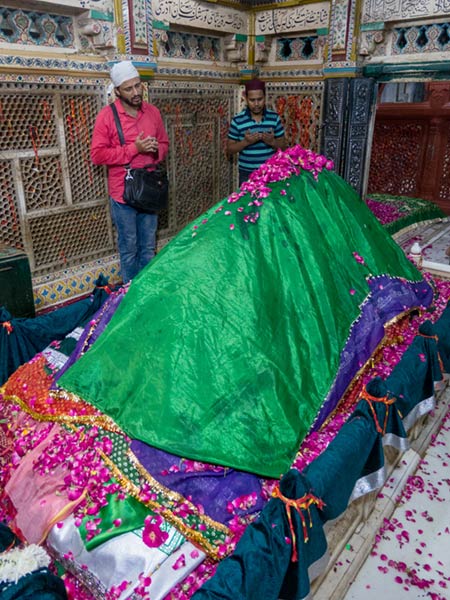
Pilgrim praying inside shrine of Nizamuddin Dargah, New Delhi
(Haryana & Punjab Photo Gallery)
The Shrine of Nizamuddin Dargah is a famous Sufi shrine located in the Nizamuddin area of New Delhi, India. It is the tomb of Nizamuddin Auliya, a renowned Sufi saint who is considered to be one of the most revered figures in the Islamic world. The site holds great religious and spiritual significance for Muslims, as it is believed to be a place of blessings and divine intervention.
The relationship between the Shrine of Nizamuddin Dargah and Hinduism is quite unique. Despite being a Muslim site, it has been revered by Hindus for centuries. Many Hindus believe that Nizamuddin Auliya was a Sufi saint who transcended religious boundaries and worked for the betterment of all people, regardless of their faith. This is reflected in the fact that the shrine attracts visitors from all religious backgrounds, who come to seek the blessings of the saint and offer their prayers.
The Shrine of Nizamuddin Dargah has a rich history, with some records indicating that it has existed for over 700 years. Hazrat Nizamuddin Auliya was a prominent Sufi saint who believed in the idea of universal love and harmony, which drew people of various religions to his teachings. The shrine was built after his death and became a popular site for people to come and offer prayers. Over the centuries, the site has been expanded and renovated several times, with the current structure dating back to the 16th century. There are also many speculative historical references to the site, with some scholars suggesting that it was originally a Hindu temple dedicated to the goddess Devi. However, there is no concrete evidence to support this claim.
The architecture of the Shrine of Nizamuddin Dargah is quite unique and differs from other temples in the state of Haryana and India overall. The shrine is designed in the Mughal architectural style, with a large central dome and four smaller domes at the corners. The façade of the shrine is decorated with intricate floral and geometric patterns, and the interior features elaborate carvings and calligraphy. The main entrance to the shrine is through a small gateway called Chaunsath Khamba, which leads to a courtyard that is surrounded by the main prayer hall, tombs of other Sufi saints, and other smaller buildings. The tomb of Hazrat Nizamuddin Auliya is located in the center of the courtyard and is adorned with intricate carvings and calligraphy.
The site is also home to a variety of trees and plants, including neem, peepal, and banyan trees. The Nizamuddin Dargah is situated in a densely populated area of Delhi, and the surrounding geography is typical of an urban landscape. However, the area is known for its lush greenery and the presence of the Yamuna river nearby. The shrine itself is situated on a small hill, which provides a commanding view of the surrounding area.
The Shrine of Nizamuddin Dargah continues to attract visitors from all religious backgrounds and the caretakers of the shrine work hard to maintain an atmosphere of peace and harmony. The shrine is still used for pilgrimage by both Muslims and Hindus, who come to seek the blessings of the saint and offer their prayers. The site is also a popular destination for tourists, who come to admire the beautiful architecture and learn about the rich history and culture of the area.
Chronology
- 1325 CE: Nizamuddin Auliya, a Sufi saint and philosopher, arrived in Delhi and established a Sufi order known as the Chishtiya order.
- 1562: The construction of the Nizamuddin Dargah began after the death of Nizamuddin Auliya, under the patronage of Mughal Emperor Humayun.
- 1608: A new gateway to the shrine, known as the Chaunsath Khamba, is built during the reign of Jahangir.
- 1732: The shrine is renovated under the patronage of Mughal emperor Muhammad Shah and his son Jahangir.
- 18th century: The Nizamuddin Dargah was damaged during the invasion of Nadir Shah, a Persian ruler.
- 1818: British officer William Fraser settles near the shrine and becomes a patron of the site.
- 19th century: The Nizamuddin Dargah was restored and expanded by the British government.
- Late 19th century: The shrine became an important center of Sufi music and poetry.
- 1947: Following the partition of India and Pakistan, the shrine becomes a site of pilgrimage for Muslims from both countries.
- 1975: The Aga Khan Trust for Culture began a restoration project at the Nizamuddin Dargah, which continued for several decades.
- Annual Urs Festival: The Urs festival is held at the shrine every year to commemorate the death anniversary of Nizamuddin Auliya. It is held in the Islamic month of Rabi' al-awwal and includes music, poetry, and other cultural events.
- Annual Phool Walon Ki Sair: This festival is held in October and involves the offering of flowers to both the dargah and a nearby Hindu temple. The festival is a symbol of interfaith harmony between Hindus and Muslims.
- Annual Chatti Sharif: This festival is held on the sixth day of the Islamic month of Rajab and commemorates the birthday of Muhammad. The festival includes special prayers and offerings at the shrine.
- Annual Basant Panchami: This festival is held in February and marks the beginning of spring. It is celebrated at the shrine with music and poetry performances.
- Regularly: People from different religious backgrounds visit the Nizamuddin Dargah to seek blessings and pay their respects to the Sufi saint Nizamuddin Auliya. The site is believed to possess spiritual and healing powers, and is a popular destination for spiritual seekers and tourists alike.
Additional Links: